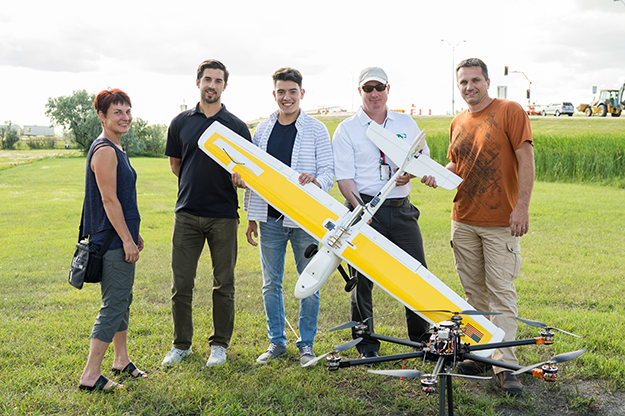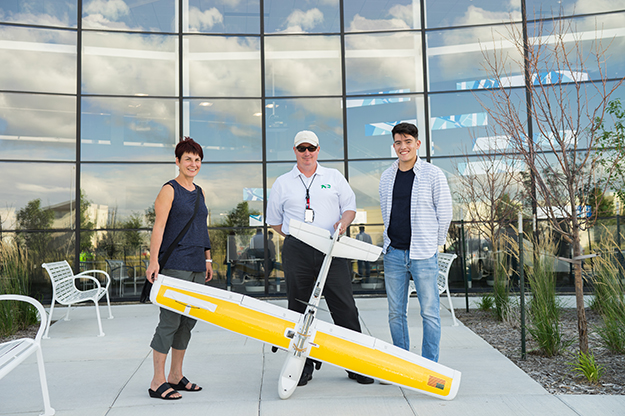High-flying chemistry
UND undergrad combines UAS and science expertise in interdisciplinary research project

University of North Dakota senior Tyson Berg hails from the little town of Walnut Grove, Minn. If you’ve heard of community of fewer than 1,000 people, it might be because it’s the childhood home of Laura Ingalls Wilder, author of the popular “Little House on the Prairie” book series that illustrates America’s early pioneer days.
But although Berg grew up around museums and parades that celebrate yesteryear, his eyes are locked on the future.
Tyson is double majoring in Chemistry and Unmanned Aerial Systems (UAS) Aviation – a recipe for great research opportunities.
“When I normally tell people that these are the two things I study, they just ask, ‘Why in the world would you do that?’ So it’s fun to tell them that I’m actually working on something that involves both,” he said. “It really feels good to do something that comes together and combines the two.”
This year, Berg has been working with UND Chemistry Professor Alena Kubatova and others across campus to research how UAS can be used to collect carbonaceous particulate matter at different atmospheric elevations. Certain carbon materials may affect cloud formations and precipitation patterns, so the team is hoping to gather enough preliminary data to support large funding proposals to the National Science Foundation (NSF), Environmental Protection Agency (EPA) and/or NASA.
“The idea is that if we show this works, we can apply for a bigger grant and get really serious research done, building maybe a bigger fleet of drones and having more students participate,” Kubatova said. “We could do more specific atmospheric processes, or maybe look at the air quality contributions of harvests or ditch fires – things like that.”
Berg’s dual know-how is a key part of this summer’s study. He earned his commercial UAS certificate in the fall, and that training, paired with the chemistry lab hours he’s already logged during his undergrad, gives him a one-of-a-kind perspective.
“You want to be able to pre-program UAS paths and take the consideration of air flow through the device, and Tyson is really in a unique position to do that,” Kubatova said.
After collecting the carbon data from the air this summer, Berg will spend the fall semester processing that data as a part of his senior Capstone course. Lab work won’t be new to him, but he knows that’s not the case for everyone.
“You should definitely seek out these experiences,” Berg advised fellow students. “Every chemistry undergraduate has to do some form of research work for their Capstone, but they should definitely get involved earlier than that, or outside of just that.”

Undergraduate support
Berg isn’t alone in urging undergraduates to get involved in research early. That’s been the goal of the Undergraduate Research/Creative Activity Initiative, funding offered through the College of Arts & Sciences for special projects like Berg and Kubatova’s. This initiative also supports Goal One of the One UND Strategic Plan, providing a strong liberal arts foundation through high-impact learning practices.
“The experience is great, but to get paid for it helps me through. The relief of having something like this is just incredible. Especially with the aviation portion of school, it gets pretty expensive.” said Berg, who is also receiving research support this summer through the North Dakota Space Grant Consortium.
Atmospheric Sciences Research Associate Professor David Delene, who is another partner in the carbon-collecting project, said the experience Berg is gaining is integral to student success.
“Involving undergrads in research provides examples of possible careers and illustrates practical applications of things discussed in classes,” he said.
Between developing air sampling systems, logging and analyzing data sets and learning to collaborate with several scientists and engineers, Berg values his growing repertoire of skills. “I look around and, in terms of my peers here, I probably have the most experience among undergraduates that I talk to,” Berg noted. “It feels good to know that I’m doing a lot.”
Cross-college links
Kubatova is quick to express gratitude to all of the graduate students and cross-campus partners who have come together to make this research work. Along with atmospheric data collection knowledge from Delene, many others have offered help in getting the team airborne. UAS Lead Flight Instructor James Moe’s abilities have been essential – flying his own equipment and figuring out how to install the sampler on the drone.
This kind of intensive collaboration, Kubatova says, is unique to UND.
“The atmospheric sciences department has more experience with certain calculations and turbulent flows,” she said. “I know more about carbon, so when they say we’ll use a plastic material to do measurements, I’m able to say, ‘Well, that could complicate everything, because it’s carbon-based and you will measure that plastic.’ So we have to use that expertise.”
And as UND pushes toward becoming a more robust research institution (as articulated in Strategic Plan Goal Four), leveraging the strengths of multiple programs will continue to become more vital.
“Collaborations are key to today’s research success since no one can do everything themselves anymore,” Delene said. “Nurturing campus collaborations leads to more successful research at UND.”


